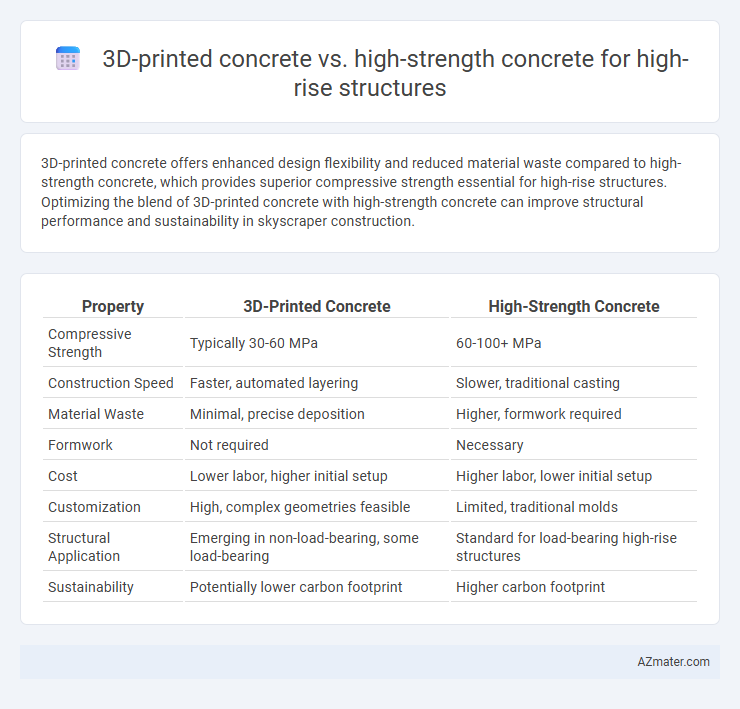3D-printed concrete offers enhanced design flexibility and reduced material waste compared to high-strength concrete, which provides superior compressive strength essential for high-rise structures. Optimizing the blend of 3D-printed concrete with high-strength concrete can improve structural performance and sustainability in skyscraper construction.
Table of Comparison
| Property | 3D-Printed Concrete | High-Strength Concrete |
|---|---|---|
| Compressive Strength | Typically 30-60 MPa | 60-100+ MPa |
| Construction Speed | Faster, automated layering | Slower, traditional casting |
| Material Waste | Minimal, precise deposition | Higher, formwork required |
| Formwork | Not required | Necessary |
| Cost | Lower labor, higher initial setup | Higher labor, lower initial setup |
| Customization | High, complex geometries feasible | Limited, traditional molds |
| Structural Application | Emerging in non-load-bearing, some load-bearing | Standard for load-bearing high-rise structures |
| Sustainability | Potentially lower carbon footprint | Higher carbon footprint |
Introduction: Evolving Technologies in High-Rise Concrete Construction
3D-printed concrete offers innovative benefits in high-rise construction by enabling precise material placement and reducing labor costs compared to traditional high-strength concrete. High-strength concrete remains a benchmark for load-bearing capacity and durability in towering structures, with compressive strengths often exceeding 70 MPa. The evolution of these technologies is driving advancements in structural efficiency, sustainability, and design flexibility for skyscrapers worldwide.
Overview of 3D-Printed Concrete
3D-printed concrete offers a revolutionary approach to high-rise construction by enabling precise layering and complex geometries with minimal material waste, contrasting with the traditional batching and placement in high-strength concrete. This innovative technology employs digital design and automation to create intricate structural components faster and with potentially lower labor costs. While high-strength concrete relies on optimized mix designs for compressive strength above 60 MPa, 3D-printed concrete emphasizes controllable rheology and buildability to achieve structural integrity in additive manufacturing processes.
High-Strength Concrete: Definition and Applications
High-strength concrete (HSC) is a specially formulated concrete with compressive strengths exceeding 6,000 psi, commonly used in high-rise structures for its superior load-bearing capacity and durability. It enables the construction of slender columns and long-span beams, reducing material usage while maintaining structural integrity under high stress. Applications of HSC in skyscrapers include core walls, foundation piles, and floor slabs where enhanced strength and resilience to environmental factors are critical for safety and longevity.
Material Properties: 3D-Printed vs High-Strength Concrete
3D-printed concrete offers enhanced customization and reduced material waste through layer-by-layer deposition, with its composition tailored for optimal extrudability and bonding, though it often exhibits lower compressive strength compared to traditional high-strength concrete, which typically exceeds 70 MPa. High-strength concrete provides superior durability, higher modulus of elasticity, and greater resistance to environmental stressors, making it the preferred choice for critical load-bearing elements in high-rise structures. However, recent advancements in 3D-printing technology aim to improve the mechanical properties of 3D-printed concrete, narrowing the performance gap with conventional high-strength formulations.
Structural Performance in High-Rise Buildings
3D-printed concrete offers enhanced design flexibility and reduced material waste, enabling complex geometries optimized for load distribution in high-rise structures. High-strength concrete provides superior compressive strength and durability, essential for supporting heavy vertical loads and resisting seismic forces. Structural performance in high-rise buildings benefits from a hybrid approach, leveraging 3D-printed concrete's precision and high-strength concrete's reliability to achieve both innovative design and robust stability.
Construction Speed and Efficiency Comparison
3D-printed concrete significantly accelerates construction speed for high-rise structures by enabling continuous layer deposition without the need for formwork, reducing labor requirements and material waste. High-strength concrete, while providing superior load-bearing capacity, often involves longer curing times and complex formwork setups that can delay project timelines. The integration of 3D printing technology streamlines the construction process, enhancing overall efficiency through automated, precise material placement, which contrasts with the traditional, labor-intensive methods required for high-strength concrete applications.
Sustainability and Environmental Impact
3D-printed concrete significantly reduces material waste and energy consumption compared to traditional high-strength concrete, promoting sustainability in high-rise structures. The additive manufacturing process minimizes formwork use and optimizes material placement, lowering carbon emissions associated with concrete production. High-strength concrete, while offering superior load-bearing capacity, typically involves higher cement content, resulting in a larger carbon footprint over the building's lifecycle.
Cost Analysis: Initial and Long-Term Considerations
3D-printed concrete reduces initial labor costs and material waste through automated layering, offering significant savings in large-scale high-rise construction projects. High-strength concrete, while more expensive initially due to specialized materials and mixing processes, provides enhanced durability and load-bearing capacity, potentially lowering long-term maintenance and repair expenses. Evaluating cost efficiency requires balancing 3D printing's rapid construction and design flexibility against the proven performance and longevity of high-strength concrete in structural applications.
Design Flexibility and Architectural Possibilities
3D-printed concrete offers unparalleled design flexibility by enabling complex, custom geometries and intricate architectural details that are difficult to achieve with traditional high-strength concrete. This technology allows for the creation of organic shapes and optimized structural forms, reducing material waste and construction time in high-rise structures. High-strength concrete, while excellent for load-bearing and durability, often limits architectural possibilities due to formwork constraints and less adaptability to unique design specifications.
Challenges, Limitations, and Future Prospects
3D-printed concrete faces challenges such as limited material strength, anisotropic structural behavior, and slower construction speeds compared to high-strength concrete, which offers superior durability and load-bearing capacity critical for high-rise structures. Limitations in 3D-printed concrete include difficulty in achieving uniform reinforcement integration and automated quality control, whereas high-strength concrete requires extensive curing times and higher costs. Future prospects for 3D-printed concrete involve advancements in composite materials and robotic technologies to enhance performance, potentially complementing high-strength concrete in complex architectural designs.

Infographic: 3D-printed concrete vs high-strength concrete for high-rise structure
 azmater.com
azmater.com